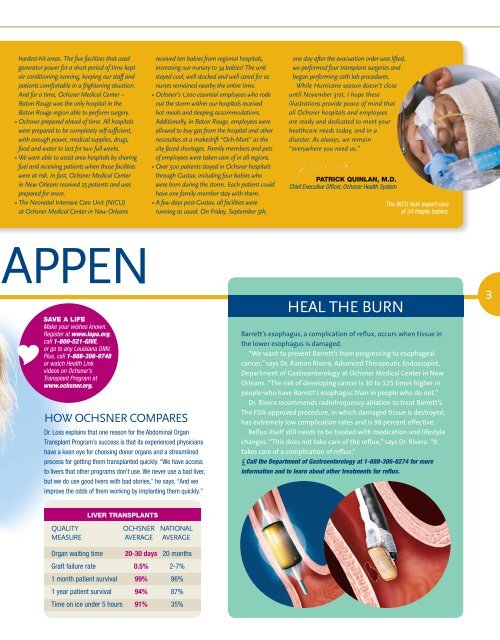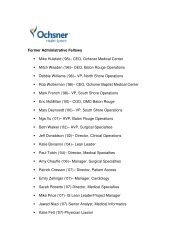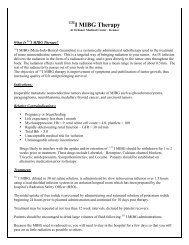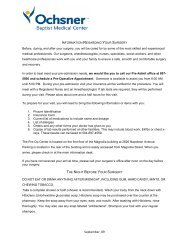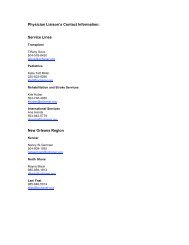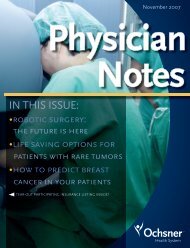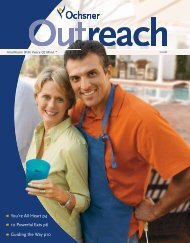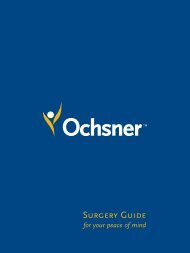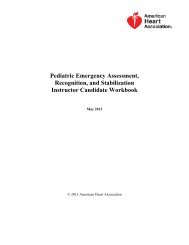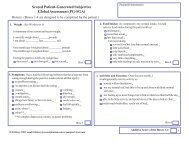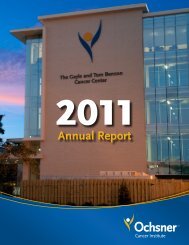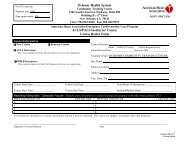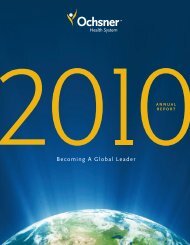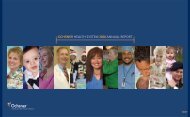NANCY DAWES - Ochsner.org
NANCY DAWES - Ochsner.org
NANCY DAWES - Ochsner.org
Create successful ePaper yourself
Turn your PDF publications into a flip-book with our unique Google optimized e-Paper software.
hardest-hit areas. The five facilities that used<br />
generator power for a short period of time kept<br />
air conditioning running, keeping our staff and<br />
patients comfortable in a frightening situation.<br />
And for a time, <strong>Ochsner</strong> Medical Center –<br />
Baton Rouge was the only hospital in the<br />
Baton Rouge region able to perform surgery.<br />
• <strong>Ochsner</strong> prepared ahead of time. All hospitals<br />
were prepared to be completely self-sufficient,<br />
with enough power, medical supplies, drugs,<br />
food and water to last for two full weeks.<br />
• We were able to assist area hospitals by sharing<br />
fuel and receiving patients when those facilities<br />
were at risk. In fact, <strong>Ochsner</strong> Medical Center<br />
in New Orleans received 25 patients and was<br />
prepared for more.<br />
• The Neonatal Intensive Care Unit (NICU)<br />
at <strong>Ochsner</strong> Medical Center in New Orleans<br />
received ten babies from regional hospitals,<br />
increasing our nursery to 34 babies! The unit<br />
stayed cool, well stocked and well cared for as<br />
nurses remained nearby the entire time.<br />
• <strong>Ochsner</strong>’s 1,200 essential employees who rode<br />
out the storm within our hospitals received<br />
hot meals and sleeping accommodations.<br />
Additionally, in Baton Rouge, employees were<br />
allowed to buy gas from the hospital and other<br />
necessities at a makeshift “Och-Mart” as the<br />
city faced shortages. Family members and pets<br />
of employees were taken care of in all regions.<br />
• Over 500 patients stayed in <strong>Ochsner</strong> hospitals<br />
through Gustav, including four babies who<br />
were born during the storm. Each patient could<br />
have one family member stay with them.<br />
• A few days post-Gustav, all facilities were<br />
running as usual. On Friday, September 5th,<br />
one day after the evacuation order was lifted,<br />
we performed four transplant surgeries and<br />
began performing cath lab procedures.<br />
While Hurricane season doesn’t close<br />
until November 31st, I hope these<br />
illustrations provide peace of mind that<br />
all <strong>Ochsner</strong> hospitals and employees<br />
are ready and dedicated to meet your<br />
healthcare needs today, and in a<br />
disaster. As always, we remain<br />
“everywhere you need us.”<br />
Patrick Quinlan, M.D.<br />
Chief Executive Officer, <strong>Ochsner</strong> Health System<br />
The NICU took expert care<br />
of 34 fragile babies.<br />
appen<br />
SAVE A LIFE<br />
Make your wishes known.<br />
Register at www.lopa.<strong>org</strong>,<br />
Ycall 1-800-521-GIVE,<br />
or go to any Louisiana DMV.<br />
Plus, call 1-888-306-9748<br />
or watch Health Link<br />
videos on <strong>Ochsner</strong>’s<br />
Transplant Program at<br />
www.ochsner.<strong>org</strong>.<br />
How <strong>Ochsner</strong> Compares<br />
Dr. Loss explains that one reason for the Abdominal Organ<br />
Transplant Program’s success is that its experienced physicians<br />
have a keen eye for choosing donor <strong>org</strong>ans and a streamlined<br />
process for getting them transplanted quickly. “We have access<br />
to livers that other programs don’t use. We never use a bad liver,<br />
but we do use good livers with bad stories,” he says. “And we<br />
improve the odds of them working by implanting them quickly.”<br />
heal the burn<br />
Barrett’s esophagus, a complication of reflux, occurs when tissue in<br />
the lower esophagus is damaged.<br />
“We want to prevent Barrett’s from progressing to esophageal<br />
cancer,” says Dr. Ramon Rivera, Advanced Therapeutic Endoscopist,<br />
Department of Gastroenterology at <strong>Ochsner</strong> Medical Center in New<br />
Orleans. “The risk of developing cancer is 30 to 125 times higher in<br />
people who have Barrett’s esophagus than in people who do not.”<br />
Dr. Rivera recommends radiofrequency ablation to treat Barrett’s.<br />
The FDA-approved procedure, in which damaged tissue is destroyed,<br />
has extremely low complication rates and is 98 percent effective.<br />
Reflux itself still needs to be treated with medication and lifestyle<br />
changes. “This does not take care of the reflux,” says Dr. Rivera. “It<br />
takes care of a complication of reflux.”<br />
£ Call the Department of Gastroenterology at 1-888-306-8274 for more<br />
information and to learn about other treatments for reflux.<br />
3<br />
LIVER TRANSPLANTS<br />
QUALITY<br />
<strong>Ochsner</strong> National<br />
MEASURE Average Average<br />
Organ waiting time 20-30 days 20 months<br />
Graft failure rate 0.5% 2-7%<br />
1 month patient survival 99% 96%<br />
1 year patient survival 94% 87%<br />
Time on ice under 5 hours 91% 35%


